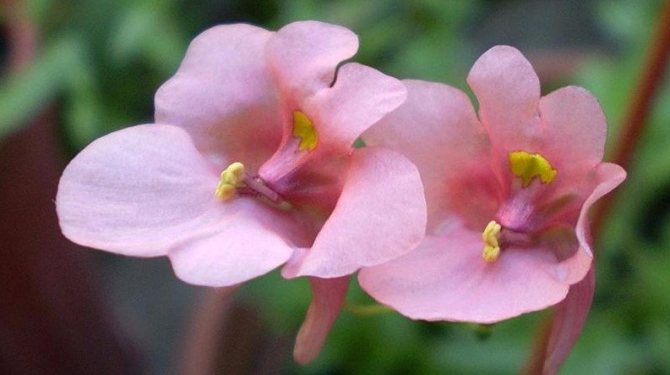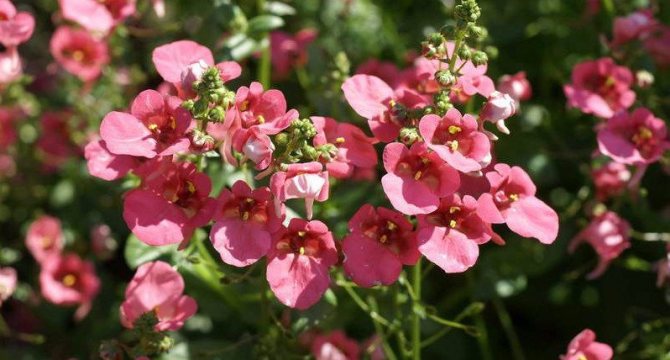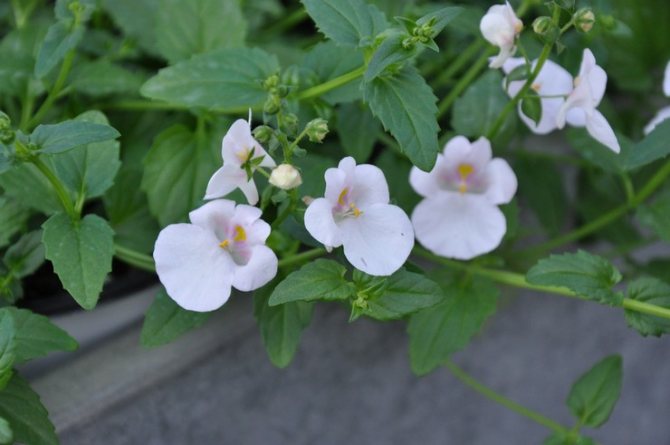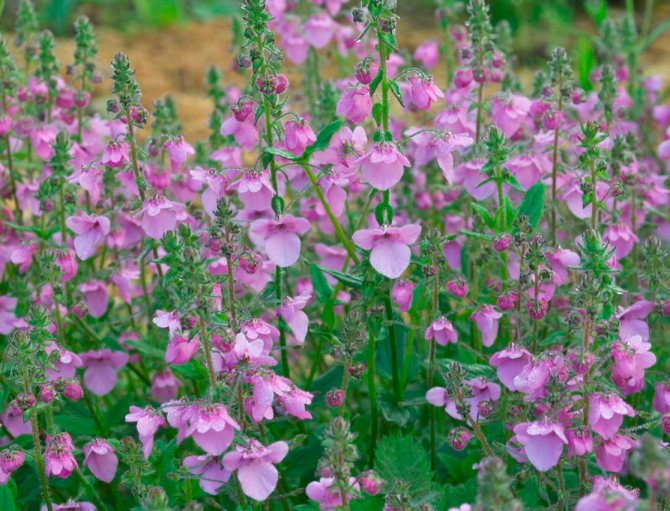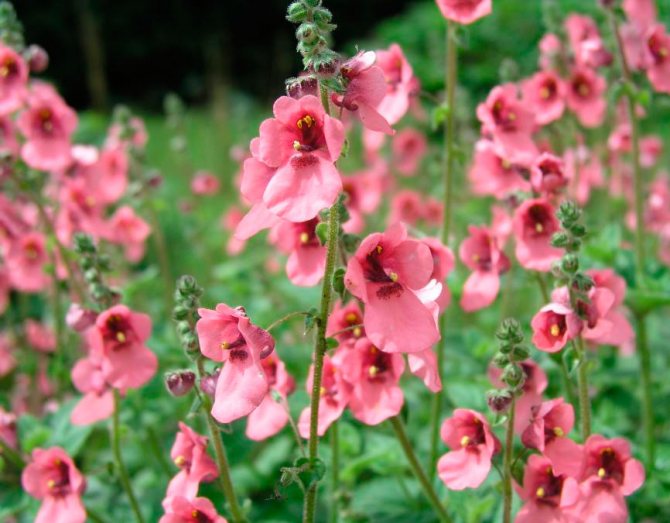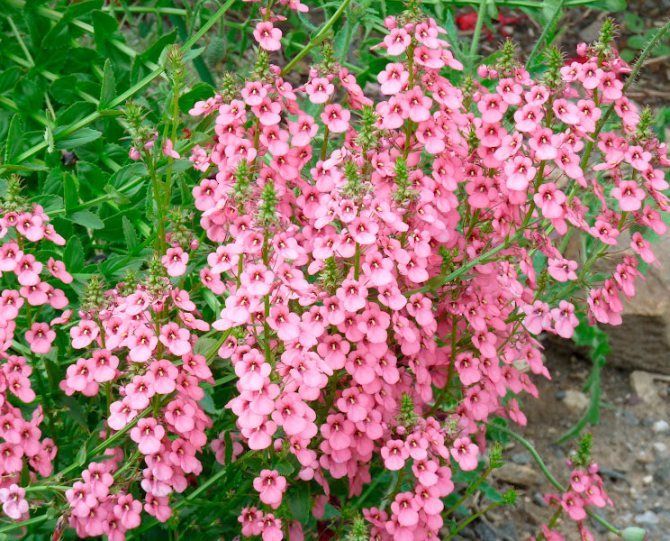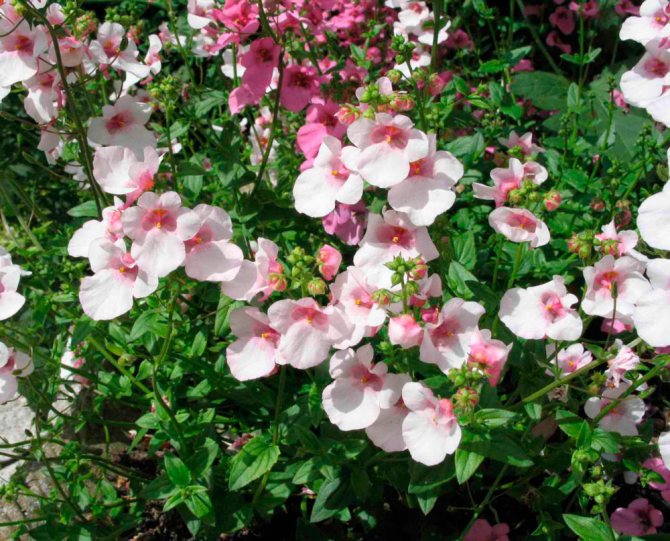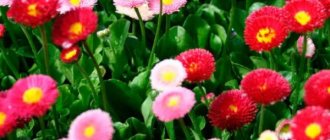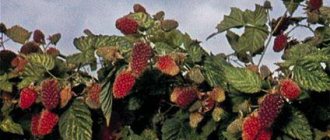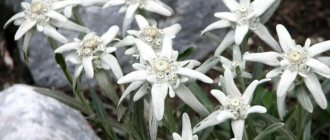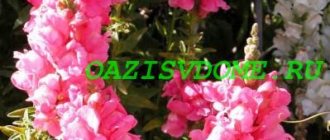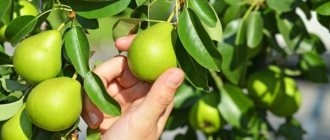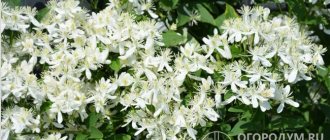The flowering plant Diascia belongs to the Noricidae family. This genus unites 68 species, which are represented by evergreen or semi-deciduous annuals and stolon perennials. This plant comes from South Africa, where it grows mainly in mountainous regions. This plant is quite popular among European gardeners. As a rule, perennial species prefer to grow in the mountains, and annuals in arid plains. Diastia is cultivated in the open field as a curb plant or in a flower bed, and it can also be grown in containers or suspended structures.
Types and varieties of diastia
Vigilant diastia (Diascia vigilis)
- a species with hanging shoots up to half a meter long and pink flowers.
Felt diastia (Diascia fetcaniensis)
- a plant with relatively small pale green rounded leaves, densely pubescent with soft hairs. Peduncles of this species are up to 25 cm high. Dark pink flowers, speckled with red strokes, bloom on them. The diameter of the flowers with forward spurs giving them an unusual appearance is about 2 cm. This species can withstand frosts down to -15 ºC.
Diascia rigescens
in the western and southern regions of England it is grown as a perennial plant, but in Holland it dies in winter. That is, this type of diassion can be called conditionally cold-resistant. The shoots of the plant reach a length of 50 cm. Leaves, which acquire a reddish-brown hue in autumn, are concentrated at the base of the bush. Flowers up to 2 cm in diameter are colored dark pink.
Diascia barberae
- an annual in our climate a branched plant up to 30 cm high, which blooms, barely reaching a height of 7-10 cm. The leaves of this species are small, glossy, dark green, located mainly at the base of the plant. Numerous flowers with a diameter of about 1.5 cm in various shades of pink with a yellow spot in the throat bloom on the peduncles. In culture, such garden forms of bearded diastia are popular:
- - Diastia Pink Queen - a garden form with inflorescences of a light pink shade with a milky tint;
- - Apricot queen - shape with orange flowers;
- - Salmon queen - garden form with orange-pink flowers;
- - Basia diastia is an annual variety that blooms twice a season with drooping velvety bright pink flowers up to 2 cm in diameter;
- - Ruby Field is a variety with dark pink flowers.
Diastia Blackthorn Epricot
- a hybrid variety with lodging stems and large spur flowers of warm shades of pink: from delicate apricot to salmon pink.
Diaztia Elegance
- hybrid garden form of unknown origin. It is a powerful, unpretentious plant with drooping stems, dense dark green shiny foliage and light pink flowers with a dark speck in the throat.
Jack Elliot
- garden variety of diastia of unexplained origin up to 40 cm high with shoots densely covered with bright green shiny leaves. Flowers with a diameter of at least 25 mm, dark pink or cherry-red in color, have a purple spot in the pharynx, above which a yellow depression is visible.
Description of the plant diascia
Stems can be erect, creeping, or lodging. In their natural habitat, they can grow up to 1 m, and in the garden no higher than 40 cm. The leaves are not large, sessile, linear, serrated at the edges, elliptical and opposite, green. The flowers are tubular, up to 2 cm in diameter. The perianth is five-lobed. Flowers can be of different colors: pink, orange, purple, white, salmon, etc. Flowering begins in June and lasts until late autumn. Diastia is quite frost-resistant, it is grown more often as an annual.
Planting and rules of care for diastia
Diascia is considered an unpretentious crop. For good growth and abundant flowering, it needs sunlight, a warm atmosphere and good watering.
Reproduction
There are two ways to grow a new plant:
- from seeds;
- by cuttings.
Growing diastia from seeds at home will help acquire new desirable species and varieties. With their help, it is easy to prepare seedlings for planting in open or closed ground. A culture grown in this way will delight you with flowering already at the beginning of summer.
To obtain seedlings, you must:
- choose a small (preferably cassette) capacity;
- pick up a substrate with neutral acidity;
- purchase seeds.
Sowing should start at the end of February. To lighten the soil, you can add a small amount of sand or mix the seeds with sand (this will help to distribute the crops more evenly).
Since the breeding material is quite small, it does not need to be pressed in or covered with earth. It is enough just to distribute over the surface of the soil. Then pour it well with warm water using a spray bottle.
Cover the container with crops with a foil, lid or glass and put in a warm place. Ventilate the soil daily, removing the formed condensation and monitor the moisture content of the soil.
After 14 days, sprouts should appear. Then the container should be placed in a well-lit, warm place. After the first true leaves appear, the sprouts must be dived into separate pots. After the newly-baked flowers get stronger, they can be planted in open ground or in pots (around May).
Planting and growing Lavender Pink diastia from seeds, photo:
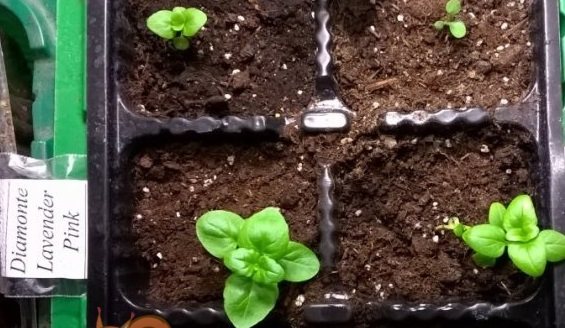
If the mature shoots are intended for pots, then they should be planted together in several shoots. If the landing is carried out in open ground, the distance between the holes must be observed (15-16 cm).
A faster way to get an adult plant is by cuttings. Cuttings should be 7-10 cm in size. They are placed in a moist, neutral substrate. After the sprouts grow, they are pinned to obtain a more lush bush. Then you can plant.
Watering
If the plant is in a planter, good drainage must be ensured. Diastia does not like dryness and stagnant water. Watering should be done as the soil dries out.
In the open field, watering will be required less often. It is better to moisten the earth in the morning or evening. This way the moisture will evaporate less.
Fertilizers
The flower does not need feeding and can do quite well without any feeding. Occasionally you can feed it with mineral complexes. The culture does not tolerate organic fertilizers categorically. Their use leads to the elongation of the shoots and the cessation of flowering.
Pruning
Since flowering occurs in several passes, it is necessary to create favorable conditions for the second appearance of buds. For this, the faded shoots are shortened by half.
Then, for a week, the bush is not watered, and then abundant watering is carried out. This will help activate the growth of new stems and buds.
Reproduction of diastia
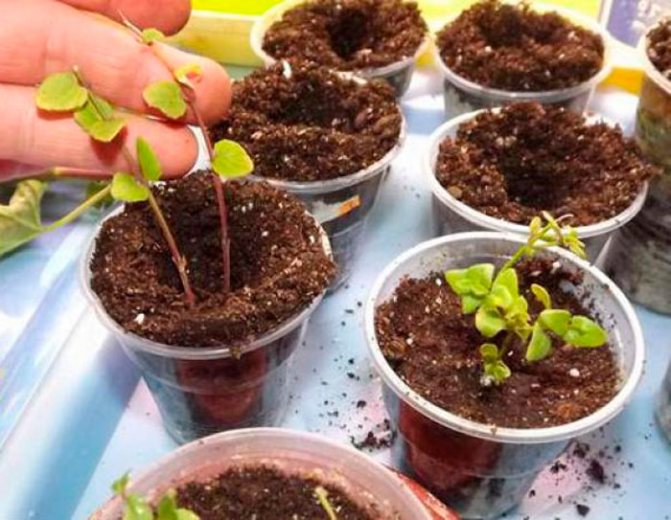

How to grow diastia from seeds was described above. Also, cuttings can be used to propagate this plant. Rooting of stem cuttings is carried out in the last summer weeks.To do this, they are planted in a moist soil mixture and kept at room temperature. In autumn, if desired, the plant can be propagated by root cuttings. In spring, as planting material, you can use the shoots that remained after pruning the overwintered bush. Cuttings should be about 8 centimeters long. When the cuttings take root and begin to grow actively, pinching of the tops of the stems should be carried out to stimulate tillering.
Plant propagation
Diastia is not very difficult to care for and reproduce. Florists successfully use the following two breeding methods:
- seeds;
- cuttings.
With the seed method, diastia is planted in the middle of winter in boxes with prepared soil. The seeds are placed on the surface of the soil, slightly pressing them, but they are not sprinkled with earth on top. After sowing, the boxes should be covered with glass or plastic and placed in a warm place in the light. Sprouts should appear within 1.5-3 weeks. With their appearance, containers with seedlings are placed where it is cooler. And when 2-3 leaves appear in the plants, the seedlings are dived.
How to plant diastia


Diascia seeds are extremely small
When planting diastia using seeds, it is recommended to adhere to the following algorithm:
- Seeds selected for planting should be placed in a container with crushed loose substrate.
- Slightly press each seed to wet soil, without sprinkling it with earth. As a substrate, both when sowing seeds and when picking, it is optimal to use a soil consisting of sand and garden soil, which has a slightly acidic reaction, not very nutritious.
Care after landing
The container in which the seeds are planted should be covered with foil to create the optimal temperature and humidity level.
To maintain the best temperature for seed germination (21-22 ° C), the container with seeds should be ventilated with the required frequency. After the emergence of seedlings, which occurs during the first 10 days, the film must be removed, and when the first pair of leaves appear, it must be cut into separate containers.
Throughout the entire period of growing seedlings, an average level of soil moisture should be maintained, avoiding either drying out or abundant soaking of it with water.
In order to form bushes, it is recommended to pinch the growing seedlings several times.
Flower care
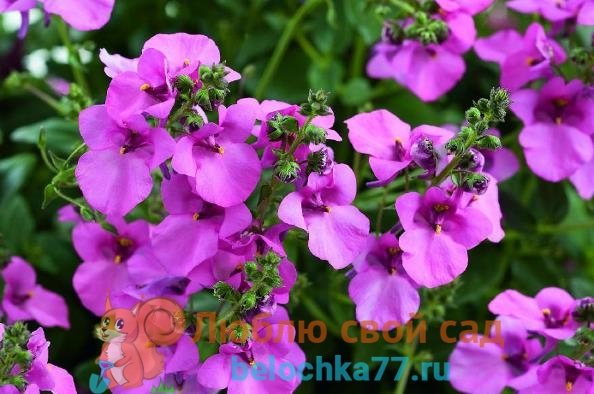

Diaztia loves warmth, but excessive heat affects her negatively. In hot weather, the buds can dry out and flowering ends ahead of time. Pay attention to the following requirements for outdoor diassage care:
- Watering. Plants are watered in pots more often than in open ground. The soil should always be slightly moistened, while there should be no stagnant water. Watering is desirable in the morning or evening, so that moisture does not evaporate too quickly.
- Top dressing. Diastia does not require a high nutritional value of the soil, and does not tolerate organic matter at all. Many people successfully grow it without using fertilizers at all. If you wish, you can feed her once a month with a solution of mineral fertilizers for flowering plants. From organic matter, shoots are pulled out and flowering stops.
- Pruning. After the first wave of flowering, the shoots of diascia must be shortened. The stems are cut in half and do not water the plant for 1 week, after which it is required to water abundantly. This stimulates the active growth of new shoots and budding. A second wave of flowering occurs.
For gardeners, diastia is considered an unpretentious plant. In principle, warmth and moisture are all that she needs for successful growth and the appearance of inflorescences.
When to plant: general dates and best dates for the lunar calendar
Usually seeds of diastia are sown for seedlings in late February - early March. When planting seedlings in garden land at the end of May, flowering begins in June (about a month later).
When choosing a landing date, it is necessary to focus on the climate of a particular region. As a southern plant, diastia loves warmth and sunshine. Therefore, in the northern regions, planting in the ground should be carried out later - in early June, while in more southern latitudes, the optimal time is mid-May.
According to the lunar calendar, in 2019, the best dates for sowing seeds of ornamental plants are: February 18, 20, 21. These days are favorable for both annuals and perennials. For annuals, suitable for February 20-28.
Features of diassage care
After planting, diastia will not require special care. But, of course, you shouldn't completely ignore the plants either. When caring for these flowers, you must:
- carry out regular watering;
- occasionally do top dressing;
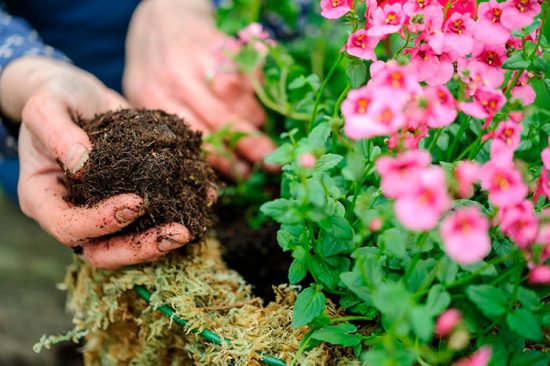

Water and feed diastia occasionally
- prune plants after the end of the flowering wave.
Advice. Watering of plants is done in moderation, without strong waterlogging of the soil. With an excess of water and stagnation in the roots of the plant, the flowers will hurt more often and may even die.
Flowers that are grown in hanging pots and containers are watered more often than those in open soil. Fertilizers should be applied to the soil very moderately, otherwise it will affect the quality of the flowering of the diastia. But pruning plants is quite an important part of caring for these flowers. It is usually done after the end of the flowering wave. It is also necessary to promptly remove already dried inflorescences. This will make the flowering period even longer.
Admiring the beauty of diastia throughout the season, taking care of it, many flower growers in the fall are sorry to leave plants grown as annuals, just to die from the onset of cold weather. But you can extend the life of this plant if the house has a place to place it for the winter. To do this, in the fall, diastia is dug out of the ground, cut in half, transplanted into a container with fresh soil and placed in a cool, but well-lit room.
These flowers do not require special care in winter, unless you only need to water them occasionally. The next year, they can be planted again on the site. Flowers left for the winter can also be used for reproduction and new plants.
Other perennial ampelous plants
You can also use other ampel flowers to decorate your home or in landscape design.
Rhipsalis - ampelous forest cactus
Ampel cactus is unpretentious in cultivation, propagated by seeds or cuttings. The plant has thin and long stems on which small but very beautiful flowers appear. The blooming chilocereus cactus looks quite elegant and decorative. Such a beautiful and soft thorn is suitable for decorating your home or any office.
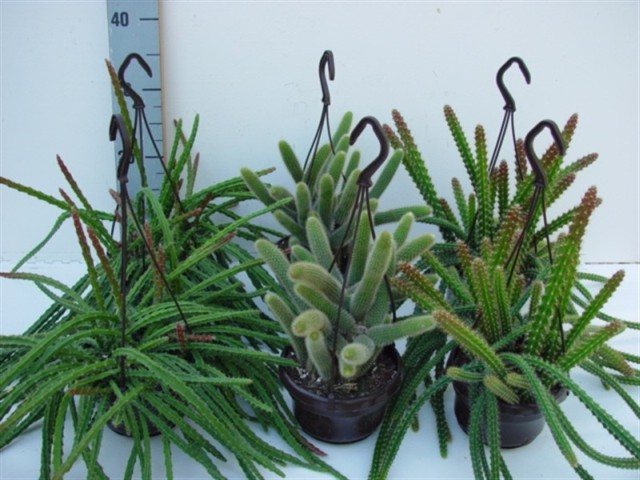

Ampel cactus in pots
Tuberous ampelous begonia
This type of begonia is distinguished by many beautiful double or semi-double flowers, which are located on long stems. Begonia blooms almost all year round, which gives it special value. You can propagate such a begonia by simply cutting the tuber and rooting it. Anyone can easily grow a flower if they know how to plant a tuberous begonia and how to care for it.
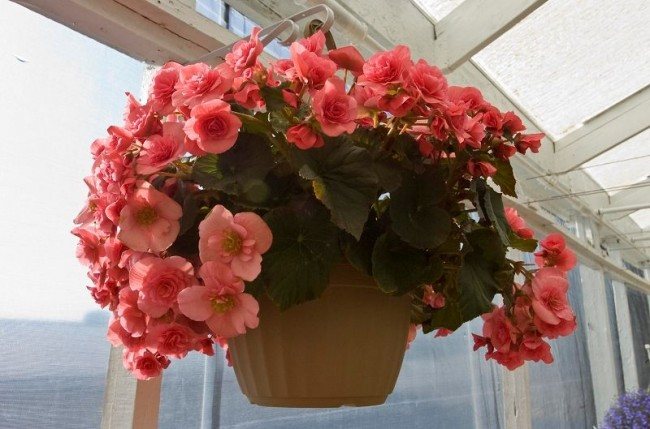

Ampel tuber begonia in pots
Katarantus (periwinkle) ampelous
Periwinkle ampelous Riviera has long stems that are capable of rapid growth and branching. It blooms with large, long unfading and dense flowers of a blue or purple hue. The flowering period is quite long - from late May to late August.
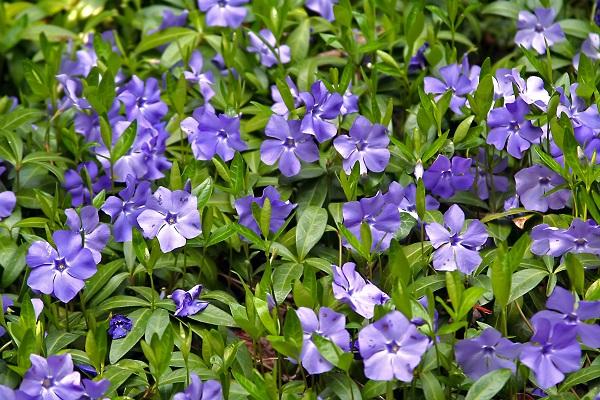

How ampelous periwinkle blooms
Bacopa ampelous
The bakopa trailing plant is an annual or perennial that can be grown for several years in a row.As a rule, in warm climates, bacopa is grown as a perennial, and for the period of cold weather it is simply well covered. In the northern regions, the plant is most often grown as an annual, since it is impossible to determine whether or not it will survive in severe frost.
The description of Bacopa says that it is a plant with long stems, small leaves of green-olive color, located in pairs on the shoots. This is an ampelous flower, which, depending on the variety, amazes with a variety of shades. There are some very amazing varieties of the Bacopa plant, for example, Scopia Double Lavender, in which the flowers have a two-tiered arrangement of petals.


Bacopa ampelous in pots
Blue
Bacopa blue has a long flowering period. Does not require special attention or any special care. Can be planted not only in hanging flowerpots, but also used for planting in open ground.
Pink
Bacopa rosea has long shoots (up to 60 cm) with beautiful openwork leaves and delicate flowers that are painted in a lavender shade. The flower goes well with petunia.
Blue avalanche
This variety has long drooping stems and many green leaves. Flowers are both lilac and blue. Differs in a rather long flowering. Cultivation of Bacopa Blue Avalanche is possible by means of seeds, as well as by cuttings.
Lilac
Bacopa lilac is distinguished by long stems, lush, dense foliage and small lilac flowers. Doesn't need a lot of light and grows well in the shade.
Carolina (Bacopa Caroliniana)
The peculiarity of the variety is long light green leaves, which, under the influence of direct sunlight, change their color to a copper-red hue. The flowers are bright blue, small. Grows well in the shade.
Gulliver pink
Bacopa Gulliver Pink is distinguished by a lush bush, as well as pink and fairly large flowers. This variety is considered quite capricious to grow.
Bacopa Monnieri Psychosis
This plant is also called small-leaved bacopa. Differs in long creeping stems with small leaves. The sheet plate has an oblong shape and a rounded top. Sheet length 0.8-2 mm. Small flowers of white, blue or purple color.
For your information! The Bacopa Monye plant is used in Chzhud Shi (Tibetan medicine).
Home ampelous plants will decorate a window or balcony, and will also become an exquisite element in landscape design. There is plenty to choose from - diastia, bacopa, catharanthus and others.
Cultivation of ampelous diastia from seeds: planting, picking and growing
Growing diastia from seeds is the preferred method of propagation for this plant. Planting is carried out in early February without burying the seeds under glass. This will require a well-structured soil with high fertile properties, a flat box or plastic container, glass or polyethylene.


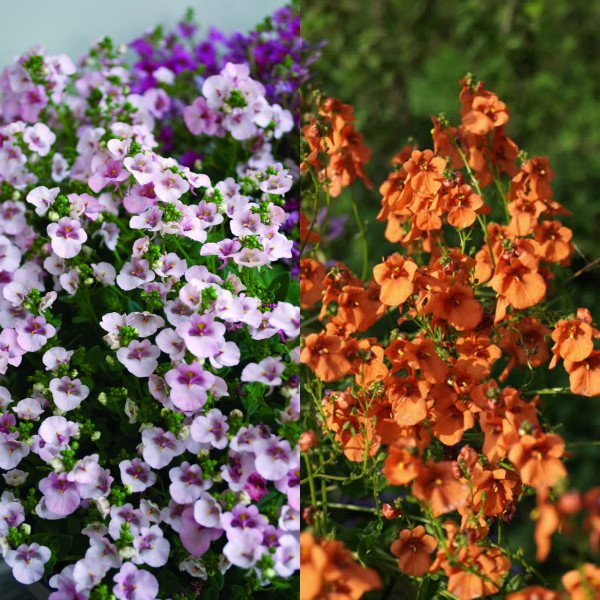

Planting diastia begins with the preparation of the seeds. The bag should be placed in the refrigerator for 2 weeks. Then the container is filled with 2/3 of the volume with soil. The earth needs to be compacted and shed with warm water. Then spread the seeds over the surface and moisten them with a spray bottle. Cover with glass or polyethylene on top and put on a windowsill, where the sun's rays penetrate well. The first shoots appear after 14 days. After their appearance, you need to start daily airing. To do this, the film or glass is removed on the first day for 15 minutes, on the second - for 30 minutes, and so on, adding 15 minutes every day. A week later, when all the seeds have sprouted, the foil can no longer be covered. Now it remains to wait for the moment when the first real leaves appear. Seedling picking begins at the moment of full development of the first pair of true leaves.Further growing after picking consists in daily light watering and the introduction of mineral liquid dressings once a week.
Reproduction methods
Cultivation of diastia at home is carried out in two ways: from seeds and cuttings. Let's consider each of them in more detail.
Seed reproduction
It should be noted right away that with seed reproduction, the diastia grows quite quickly and gives buds around July. So the procedure looks like this:
- At the end of winter (in February) we select good seeds and sow them in containers with a substrate. In this case, each seed must be carefully pressed into the ground, do not sprinkle it with soil on top.
- We spray the planted seeds with water at room temperature and cover each box on top with polyethylene or glass. We transfer to a warm place, the temperature in which should constantly be at around + 22 ° C.
- Before the first shoots appear, containers must be opened from time to time, ventilated and moistened.
On a note! With proper agricultural technology, the first shoots will appear two to three weeks after sowing! - After the seeds give the first shoots, we remove the polyethylene, and the containers are transferred to a well-lit place, the temperature in which will already be somewhat lower: about + 15..17 ° C.
- When two true leaves appear, we dive the seedlings into separate cups with drainage holes.
- When growing diastia from seeds before planting plants in soil or permanent pots, the soil in containers should be kept moist.
In May, matured and grown ampelous varieties of diastia can be determined in hanging baskets, and erect species - in open ground.
On a note! You can sow seeds of diastia directly into open ground. However, remember that in this case, the plants will not begin to bloom until August!
Cuttings
You can also propagate diastia by cuttings. For this:
- Separate root cuttings from adult bushes, on which several leaves have survived.
- We plant the resulting cuttings in pots with a substrate and place them in a well-lit room, in which it must be cool - in such conditions the plants overwinter.
- After about a month, the top of the diastion must be pinched - this event will help the plant to bush better in the future.
With this method of reproduction, plants are planted in the ground in the last decade of May.
Care and conditions
Soil and fertilizers
Diastia will bloom luxuriantly when planted in less fertile soil. Sandstones and sandy stones are well suited for her. It is better to pour the purchased universal earth mixed with sand into the tubs.
The plant does not need constant addition of fertilizers. With excessive application of fertilizing, the stems of the plant become elongated, and they do not bloom.
Therefore, the bushes are fed once a month with a weak nutrient solution for garden plants.
Humidity and watering
Water the bushes once a week. They do not like both drought and waterlogging.
Features of care in summer and winter
You can plant seedlings in a flower bed from the third decade of May. Observe a distance of at least 15 cm between flowers when planting.
You can also plant 2-4 seedlings in hanging baskets and pots with a volume of 5-6 liters.
After the diastia has faded for the first time, the stems are cut in half and the faded inflorescences are cut off. After pruning, you need to feed and water abundantly for a week. This stimulates the growth of the stems and then the plant blooms again.
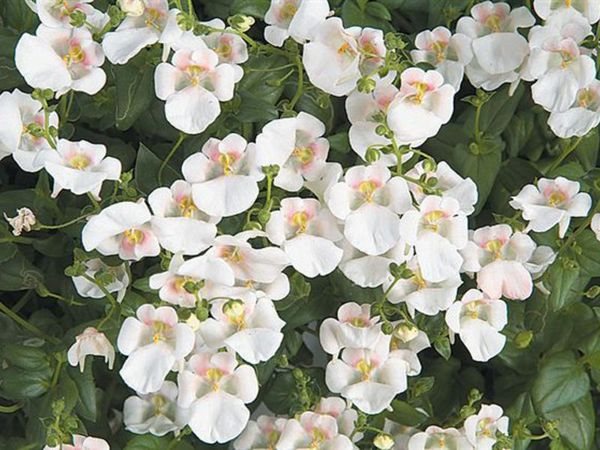

Timely pruning stimulates flower growth
The plant does not tolerate frost, because of this, dig up and discard the flowers in the fall. Or in the fall, before the frost, you can bring a flowerpot with flowers into a room with a temperature of +5 ° C. Further:
- cut the stems in half
- transplant flowers into other containers with fresh soil
- put in a well-lit place
Water the plant in winter also once a week. If the diagonal lacks natural light, then it is illuminated with fluorescent lamps.
How to Grow Diacation from Seeds
The difference between home and outdoor cultivation
From the end of February, the house begins to sow seeds, throw 3 pieces in each cassette container... Instead of these containers, you can take bowls, however, the seeds need to be mixed with sand so that they fall on the ground evenly.


Cassette containers help to grow seedlings correctly
With this method, after transplantation, the plants bloom in June.
Seeds can also be sown in open ground, but this is done only in April, May, since otherwise the plants will not sprout or die due to cold weather. But with such a sowing, diastia will bloom in August.
Planting a perennial plant
For planting, they buy cassette containers or bowls, pour into them slightly acidic soil mixed with sand... Diastia has rather small seeds, so when sowing, do not put soil on them, but just press them a little against the ground.
Containers with landings are placed under the following conditions:
| Lighting | if natural consecration is not enough in winter, then backlighting can be used |
| Temperature | + 18-20 ° C |
| After sprouting | containers are placed in a cooler room with a temperature of 10 to 15 ° C |
Diastia prefers slightly moist soil, it should not be too wet or dry. Spray the soil with a spray bottle to prevent small seeds from being washed away.
Picking and rearing
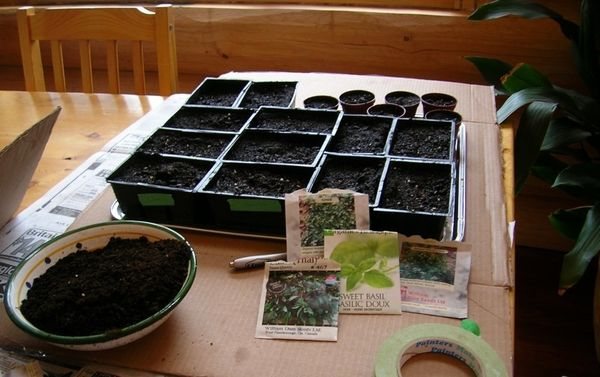

Picking seedlings helps to speed up their germination
Seedlings dive after the appearance of 2 true leaves. Seedlings dive, planting 2-4 pieces in pots or containers in early May, and immediately pinch the growth point, then the diaspora will bush.
In the future, the plants are grown by watering every day and applying mineral liquid fertilizers once a week.
Seedlings of upright diastia are placed on flower beds in the third decade of May, due to the fact that African plants cannot survive return frosts, they are observed when planting distance between flowers 15 cm.
Previously, a bucket of medium-sized expanded clay and several buckets of sand are poured into the soil.
At the same time, ampelous flowers are transplanted into hanging baskets, pots. 2-3 pieces are planted in one container.
From seedlings - differences from growing from seeds
Seeds are sown in open ground at about the same time as the seedlings are transplanted. And, accordingly, when planting seedlings, diastia will bloom much earlier. The seeds may not sprout, and a certain amount of seedlings will definitely take root.
Combination of diastia with other plants
These flowers are widely used in landscape design. Diastia ennoble open areas, plant it in pots, containers, garden vases. You can plant it on bare plots of land, making these places more attractive.
It also looks great in combination with other plants when planting in common flower beds. And the diastia planted along the edge of the flower garden in combination with taller plants looks especially beautiful.
Diascia is not just a beautiful flower. It can become a real decoration of the site throughout the season, because even in dry and hot weather, its flowering almost does not stop. At the same time, the plant does not require much attention to itself and any special care.
Diastia in landscape design
The plant is well suited for landscape design, where such properties are remarkably used:
- unpretentiousness - quite simple care and vitality of diastia allow it to be grown in different climatic zones;
- beauty - small flowers of pleasant colors adorn any landscapes, be they man-made or natural;
- versatility - can be grown in an apartment, on a balcony, in a yard, in a country house, on a personal plot.
Did you know? The Roman emperor Claudius Caesar (reigned from 4 to 41 AD) was very fond of landscaping and gave flowers from his garden not only to friends, but also to ordinary Romans.
Diastia looks equally beautiful with any environment - from flowerpots in the "Khrushchev" to an artificial landscape under an alpine meadow. Moreover, in the latter case, these flowers perfectly conceal the transitions in height and the sharp edges of the stones. Also, with their help, you can create live borders, contrasting compositions, fill in the transitions between groups of plants and use in the design of rock gardens.
Plants such as avran officinalis, foxglove, verbascum, veronica, nemesia and penstemon can also be attributed to the norichnikov family.
Diassage care at home
How to take care of diassage at home.
At home, they grow mainly ampel diastion. At seedling age, her stems are the same straight as those of a bush, but as soon as they reach a height of 30 cm, they begin to descend. Ampelous diastia does not require special care. At the bottom of the pot or basket when planting, you need to place a layer of drainage material that will not allow the roots to sour in the water. The soil for home diastia, as well as for garden diastia, needs loose, slightly acidic and not very fertile soil. The best composition is a mixture of garden soil, wet peat or leafy soil, coarse sand or perlite in equal parts.
Water the plant abundantly, but in moderation. Top dressing with liquid mineral fertilizer in low concentration is carried out once every 2-3 weeks. Do not apply organic fertilizers to the soil. Remember that an overfed plant does not bloom, its stems stretch out and weaken.
Timely remove wilted buds and cut off faded shoots so that the diastia has the strength to grow new shoots.
Trimming the diagonal.
The home diastia is cut off, like the garden one, after the first wave of flowering, leaving only 5 cm from the shoots. After pruning, the diastia is intensively watered, fed, and it begins to grow new shoots and form buds for re-flowering.
Placement of the diastography.
Ampel diastia is grown to decorate dwellings, balconies, terraces, verandas, loggias and other premises. The plant is planted in balcony boxes or containers and in suspended structures - pots or baskets. Diastia looks great in large flowerpots.
Pests and diseases of diastia.
At home, diastia almost never gets sick. Problems can arise due to an excess of nutrients in the soil: it is better not to feed diatsia at all than to overdo it with fertilizers.
Cultivation of diastia
Like any other plant, diastia requires diligence to grow. Despite their unpretentiousness, these flowers can repay with beautiful and long flowering to the owner who will treat them with love.
Placement and lighting
Given their African origin, the bushes love open space and sunlight. In apartment conditions, especially in winter, they need to be well illuminated and warmed. In the warm season, when the night temperature is not too different from the daytime, a plant in a pot, container or block will feel great on a balcony on the sunny side. You can also transplant the plant to a summer cottage or personal plot in the summer.
Soil, green manure and fertilizer
The plant grows well in soil with low acidity, which, together with warmth and moisture, mimics the natural conditions for diatsion. Also, a pet will accept a mixture of peat, ordinary earth and perlite sand in equal proportions. Flowers do not tolerate prolonged stagnation of water and may die, so they need high-quality drainage in indoor conditions and mulching with sand in the open field.
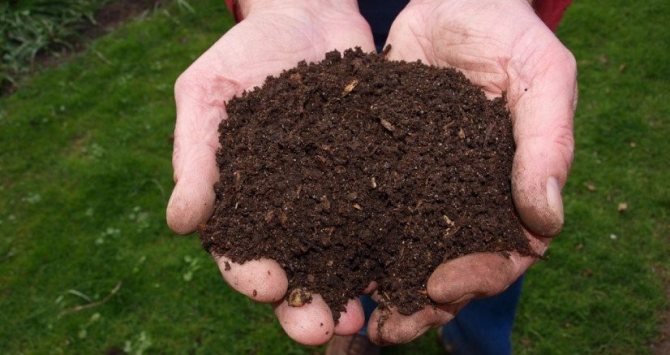

The soil in which it is planned to plant the diastium should be prepared by embedding green manure plants and fertilizers. In the form of siderates - plants that are grown on the site in their free time from the main crops and fertilizing the soil - you can plant mustard, rye, lupine or peas. As for fertilizers, they are used during the flowering period. Liquid fertilizers are used, which are applied every two weeks. It is necessary to monitor the amount of fertilizer applied, since an excess of them can help in the growth of diassage, and not in color.
Landing
This plant can be propagated using both seeds and seedlings. It is clear that seedlings with normal survival rate will develop faster, and you will have to tinker with the seeds. Florists usually prefer sowing with seeds, followed by rejection of weak shoots. High-quality seeds emerge in one and a half to two weeks and look very miniature, but they are quite viable.
Plants such as fuchsia, begonia, verbena, geranium, lobelia, petunia and dichondra can also be classified as ampelous.
Sowing seeds
The seeding and planting sequence is as follows:
- The seeds are pressed into the soil, after which they do not need to be covered with earth.
- A stable temperature (about 18 ° C) is maintained until emergence.
- After the emergence of shoots, the container with them is moved to a room with an air temperature of up to 15 ° C.


Important! Seed flowers at home will bloom in mid-summer, and seedlings in early June. In the southern regions of the country, it is possible to sow seeds directly into flower beds, but flowers will appear only at the end of August.
How to plant seedlings
Seedlings are planted before the onset of summer - in the last days of May. The seedlings are placed at a distance of 20 cm from each other. Ampel seedlings are planted in several pieces in one container. The soil for planting should be light, porous and fertile. With all the drought resistance of the culture, it is necessary to carefully monitor the soil moisture and maintain it.
Pruning
When the first flowering ends, the plant needs to be renewed. All shoots are cut to about half their length. After this operation, the flower is watered abundantly for 7-10 days. This helps him to regain strength and will sooner lead to regrowth of stems and new flowering.


Wintering
Most owners simply throw out the bushes when the cold weather sets in. However, the plant can be saved for the next season, with simple manipulations. The container in which the diastion is located can be brought into a cool room (temperature about 5 ° C). In early spring, such a plant can be propagated by cuttings.
Pests and diseases
The main "sore" for the culture is excessive watering - do not forget that the birthplace of this plant is Africa, where it managed to survive, after which it spread throughout the world. If the diastia has begun to wither or even dry, then in most cases, the problem is in the excessive moisture of its roots and the formation of root or stem rot.
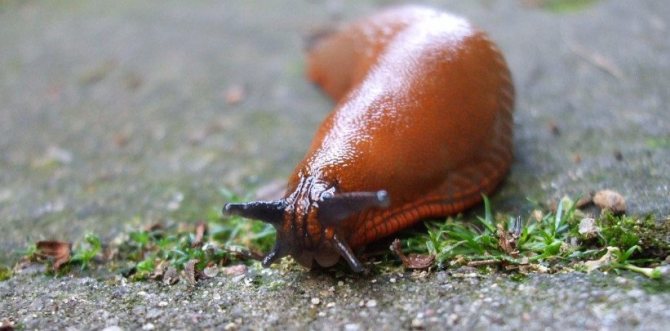

Fungal infections, as a rule, bypass this culture, but slugs and snails can harm ground leaves. In this case, you need to either remove such leaves, or arrange some kind of support for them.
Did you know? You can fight slugs in an environmentally friendly way: an old board is greased with kefir and placed with the greased side down on some supports (a couple of small stones). During the night for a treat, all the slugs from the site will be collected.
Reproduction of diastia
The plant can be propagated in two ways - by seeds and cuttings from an adult plant.
Seeds
Diastia is planted in late winter or early spring. The seeds are planted at a very shallow depth - only half a centimeter. After planting the seeds, the surface of the soil is covered with a film or other material. This is done not only to insulate future seedlings, but also to maintain the moisture necessary for growing seeds. After the first shoots appear, the film is removed and a dive is carried out.
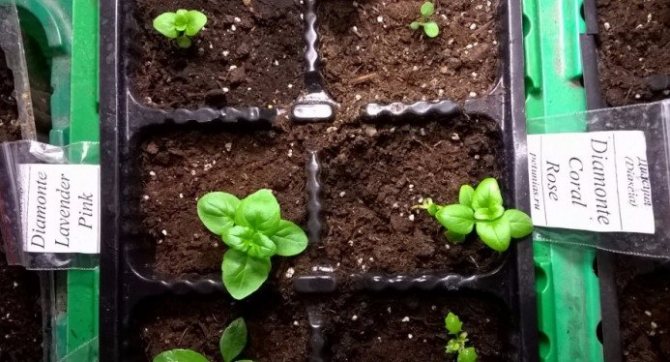

Planting diastia in the garden
When to plant a diastion.
Planting diastia from seeds into open ground is carried out in mid or late May, when the soil warms up and the threat of recurrent frosts has passed.But before planting the seedlings on the flowerbed, they need to be prepared for the environment in which they will soon find themselves: the seedlings are taken out daily in the open air, gradually increasing the duration of these sessions. By the time of planting in open ground, seedlings should be in the garden around the clock.
How to plant diastia.
Diaztia loves sunny areas, protected from the wind, with slightly acidic, not too fertile moist soil, into which it is desirable to add sand. Do not plant it in a low area where moisture collects. The best place for diastia is near the south-facing wall of the building.
Diastia bushes are located at a distance of 15 cm from each other. After embedding, the plants are watered abundantly.
Diastia care in the garden.
In hot weather and during flowering, diastia needs abundant and frequent watering, however, you should observe the measure, since the plant does not tolerate stagnant moisture in the roots. After watering, slightly loosen the soil around the bushes and remove the weeds.
Diastia does not need frequent feeding: it is enough to add a fertilizer solution for flowering garden plants in a weak concentration to the soil once a month. An excess of nutrients in the soil can cause the plant to refuse to bloom. In addition, the stems of the overfed diastia stretch out, and it loses its decorative effect.
Brief description of cultivation
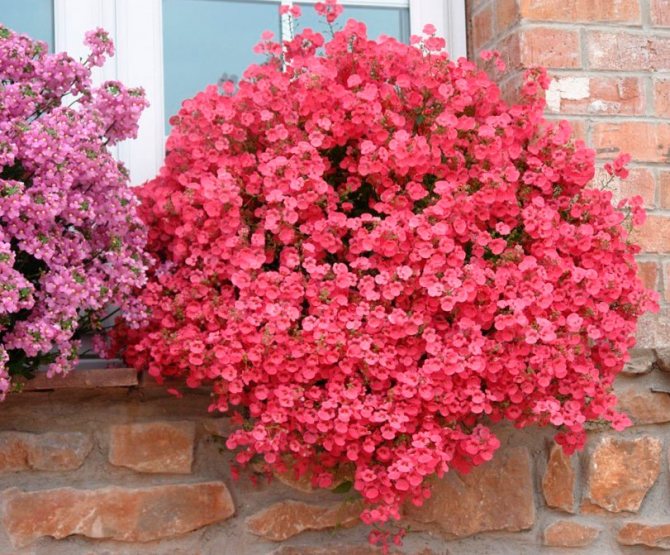

- Bloom... Flowering begins in the first days of June, and it ends with the first frosts.
- Landing... Seeds for seedlings are sown from the last days of February to the first - March, seedlings are transplanted into open soil - in the second half of May.
- Illumination... Needs lots of bright light.
- Priming... It should be slightly acidic, moist, not too nutritious and include some sand.
- Watering... In the hot dry season, as well as after pruning in the summer, water often and abundantly. If it rains systematically in the summer, then the diastia is watered moderately, but they do it systematically.
- Fertilizer... The flower is fed regularly once every 4 weeks, for this, mineral fertilizer is used for flowering garden plants, while the dosage recommended by the manufacturer on the package must be halved.
- Pruning... When the bushes have bloomed for the first time, the stems are shortened by ½ part of their length.
- Reproduction... Cutting and seed method.
- Harmful insects... Slugs and snails.
- Diseases... Stem and root rot.
Fertilization and feeding
As mentioned earlier, it is preferable to use a soil that is not oversaturated with nutrients for diassage. Fertilization should not be overused, and it is better not to use organic fertilizers at all. When caring for flowers, it is enough to feed them at least once a month. But this must be done after the end of flowering and pruning of plants. And it is better to use a complete mineral fertilizer intended for flowering plants for diastia.


Seedlings of diastia
Why is it customary to grow seedlings of diastia
Diascia is a flowering ampelous or ground cover plant. It is usually grown as an annual, but some species successfully overwinter in the garden. You can propagate a flower by cuttings or seeds. The latter option is used more often, and experienced gardeners prefer the seedling method.
Since the seeds of diastia are very small, it is best to use tweezers to work with them.
Diastia seeds can be sown directly into the ground, they tolerate daily temperature changes well and take root quickly. However, sowing on flower beds and rabatki can be carried out only in late spring, when the earth is completely warmed up. In this case, young plants begin to bloom not earlier than August. Growing from seeds at home will help speed up the process. The grown bushes are transplanted to flower beds or flowerpots in May, flowering begins in June and continues throughout the season.
The seeds of the diastia are small, slightly elongated, brown-brown in color. Germination is average, experienced flower growers note that half of 10 pieces may not hatch.
Landing in open ground


When growing outdoors, select the sunniest place for the diastion. If grown in the shade, flowering will be weak. It is better to prepare the holes in advance, and after planting the ground should be covered with mowed grass. If you are planting flowers in pots, make sure that there is no stagnant water. The container must have drainage holes.
Advice! When planting in open ground, it is recommended to mix the soil with coarse sand. It is desirable that the soil be neutral in acidity.
For the winter, plants can be dug up and placed in a room with a temperature of 5 degrees, the shoots can be cut in half. With the onset of spring, the diastium is first hardened and then planted back into the open ground.
Planting a plant
A well-lit, sunny area is selected for planting diastia. The soil on it should be light, loose, slightly acidic, sufficiently nutritious. When choosing a place for planting this plant, it is worth avoiding areas with too fertile soil, since with an overabundance of fertilizers, the diastion will bloom much worse than in poorer soil.
The cultivation of these flowers is often done in seedlings. For seedlings, diastia is usually sown in February. Young seedlings are moved to open ground already at the end of spring, when stable warm weather sets in. The seedlings are gradually hardened in the air, and only then they are planted in a flower garden, observing the distance between the seedlings of 15-20 cm.
Attention! Planting these flowers in open ground is carried out only when the threat of frost, which occurs in late spring, has already passed.
Long-term diastia in winter
In temperate climates, diastia is grown as an annual, but if you are sorry to part with it in the fall, transplant it into a pot with a loose substrate and transfer it to a bright, unheated room with a temperature of at least 5 ºC for the winter. In winter, diastia watering is reduced, and feeding is stopped altogether. With the onset of spring, change the soil in the pot, put the plant in a warm place and cut off its shoots. When the diastia begins to grow, pinch the tops of the shoots to create a lush bush. Before planting on a flower bed, carry out a two-week cycle of hardening procedures, and when all the frosts have passed, plant the plant in the garden.
Features of diassage
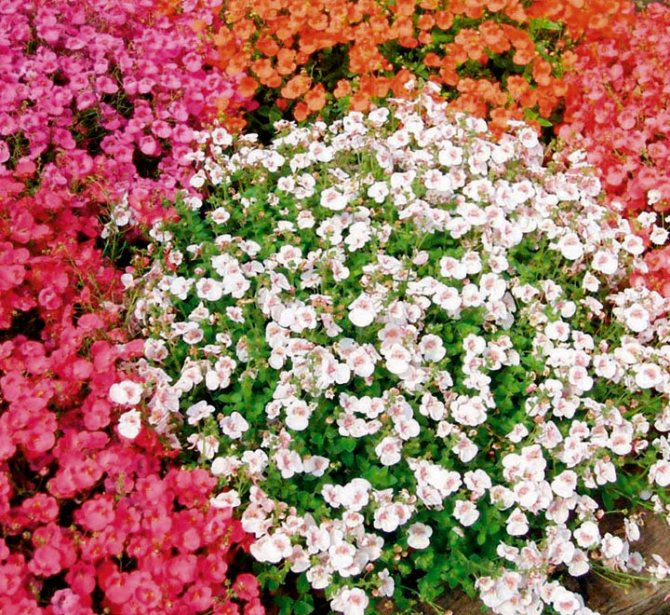

Depending on the type, the shoots of the diastia can be creeping, erect or lodging. Under natural conditions, the height of the bush can reach up to 100 centimeters, but in culture they are not higher than 20–35 centimeters, while some of their shoots can stretch up to 0.6 m. Small sessile opposite leaf plates are painted green, their shape linear elliptical and serrated edge. Tubular flowers reach about 20 mm in diameter, their perianth is five-lobed: at the base of a pair of upper lobes there is a speck of yellow color, as well as spurs, 3 lower lobes are larger than the upper ones. During flowering, an apical racemose inflorescence is formed, consisting of flowers of pink, orange, white, purple, salmon or other color.
Bushes bloom in the first days of June, and flowering ends with the first frosts. Some species are highly resistant to frost and can withstand frosts up to minus 8 degrees, and sometimes up to minus 15 degrees. However, as a rule, in temperate climates, this flower is cultivated as an annual. When grown in a garden, this plant is most often planted in mixborders or in a rock garden in order to fill the voids between the bushes of large plants. Diastia can also be planted around the perimeter of courtyards and paved areas, as well as along garden paths.Such a plant looks great in both combined and single plantings.
Types and varieties of diastia with photos, descriptions
Of the dozens of existing types of diastia, only a few are used in floriculture. Russian flower growers have a more meager choice than in Europe. For us, diastia is still a rare plant. On sale you can find seeds of the following types:
Diastia bearded
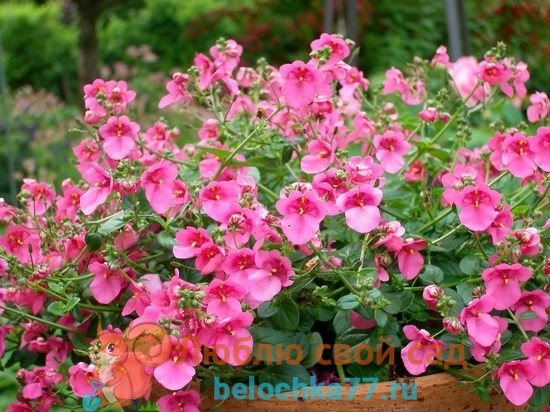

Diastia bearded Pink Queen "Pink Queen"
The variety grows into a compact bush up to 30 cm high. Flowering occurs in very young plants that do not exceed 10 cm in height. Shiny dense foliage forms a kind of pillow at the base of the bush, above which the caps of inflorescences of the most different colors rise. The plant is more often grown as ampelous in hanging containers and decorative pots. The most popular varieties of this variety are "Pink Queen" with pale pink inflorescences and "Ruby Field" - this variety has flowers with pink petals and a dark center.
Felt diastia
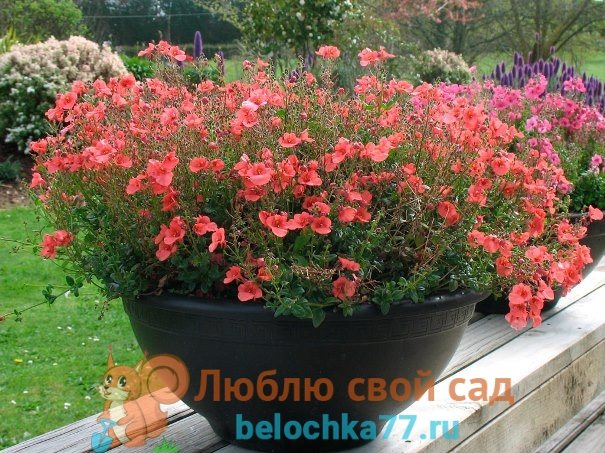

Felt diastia (Diascia fetcaniensis)
The variety grows into a dense bush approximately 25 cm high. The plant has decorative pubescent leaves, so it looks spectacular even when not flowering. During flowering, dark pink flowers with red markings bloom on the diastia. Flowering lasts throughout the summer. Can be grown on the balcony.
Diastia is harsh
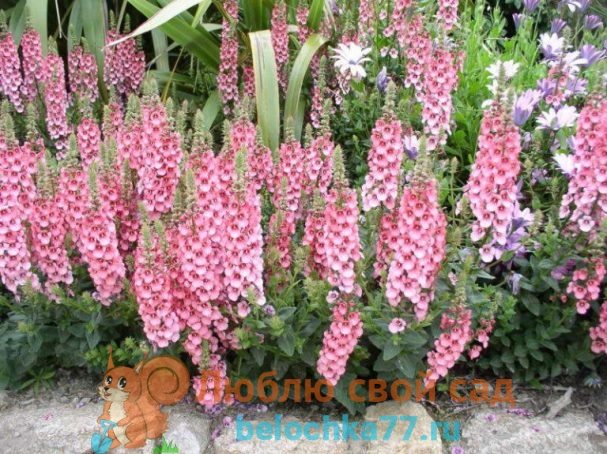

Diascia rigescens
The plant has longer shoots, up to 50 cm long. By the beginning of autumn, green leaves turn reddish-brown. Dark pink small flowers are collected in inflorescences. This variety is considered one of the most resistant to low temperatures and is grown as a perennial in European countries.
Diabetes vigilant
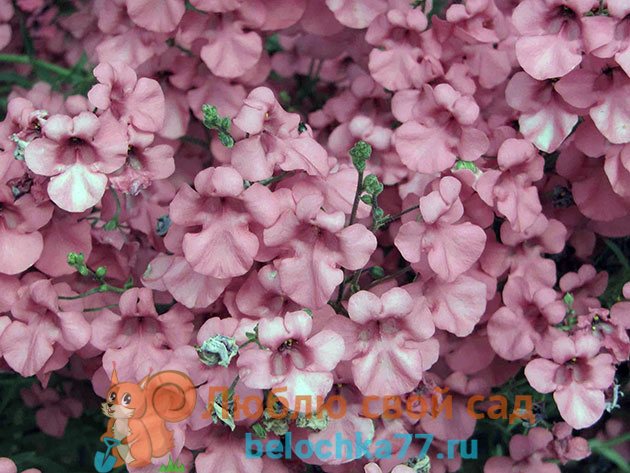

Vigilant diastia (Diascia vigilis)
Another ampelous view. Shoots grow up to 30 cm in length and have the ability to root themselves. Flowering occurs on the tops of the shoots. The color of the flowers is pink.
Diastia is elegant


A low shrub with erect or lodging stems, 30 cm high. There are many small leaves on the shoots. Flowering is abundant and long lasting. Flowers can be of various shades of pink.
Diaztia Lavender Pink


Diamonte F1 Lavender Pink
Hybrid variety "Diascia Lavender Pink" has the most abundant flowering. It grows in the form of spherical bushes. The flowers are small in size, have a lilac hue. Inflorescences almost completely cover shoots and leaves. Flowering continues throughout the summer. The variety is not sensitive to temperature changes.
Home care features and basics
As soon as the gardener begins to grow ampel diastia, he will see straight stems, from which inflorescences and leaves will grow. After the lapse of time, the stems grow up to 30 cm and go down. Thus, a sprawling bush is obtained, which will be the main decoration. Let's take a look at the basics of caring for a plant at home. Distinctive features of this representative of the tropical flora make it an excellent decoration for interiors: Dark green small leaves will be a distinctive feature. But what will pleasantly surprise you is the abundance of flowers that completely cover the plant. Thanks to the efforts of breeders, they come in all sorts of colors, most often - bright red, pink, peach. Several waves of flowering from early spring to the very frost are the main quality that gardeners appreciate.
When talking about planting and caring for diastia, there are several main points. Let's start with leaving:
- In order to achieve frequent flowering, faded shoots must be cut off so that they do not interfere with the growth of new ones;
- These are very thermophilic flowers. However, direct sunlight can dry out and depress the plant. The side of the house that is lit in the morning and half of the day is best. In this way, measured sunlight can be achieved;
- To continue growing in winter, the plant is brought indoors. In the future, new perennials are obtained by cuttings;
- It is necessary to water with water, but the earth must be dry, therefore drainage is necessary;
- Loose soil is perfect for these flowers. A mixture of equal parts from garden soil, sand, peat and rotten leaves is perfect;
- Groundbait during flowering is carried out every 2-3 weeks. For this, liquid mineral fertilizers are used, which feed the plant. Don't overdo it. Otherwise, you will not get a flowering bush, but thick stems with leaves;
- It blooms well in summer, loves warmth, but does not tolerate heat.
Diseases and pests
In dry, hot weather, Diascia can be attacked by whiteflies and aphids. You can get rid of them with insecticides. If the plant is located on the site, then an attack by snails and slugs is possible. To prevent this problem, you should tie the creeping shoots to the support. And the emerging slugs or snails are collected manually and removed from the site.
Excessive watering and rainfall can lead to root or stem rot. In such a situation, it is necessary to adjust the watering, remove severely damaged areas and treat the plant with a fungicide. This treatment can be carried out in advance for prevention purposes.
Popular flower varieties with photos
Botanists have about 50 types of diastia, wild-growing and bred by breeders.
Bearded
Bearded diastia is one of the most unpretentious plant varieties.
Compact bushes up to 30 cm high are covered with smooth shiny leaves and a large number of buds. Flowering occurs in waves throughout the season. Flowers of all shades of pink, from very light to rich. An annual plant, suitable for flower beds, flower beds and flowerpots.
Ampelnaya
Diastia is great for vertical compositions in landscape design.
Suitable for verandas, balconies, hanging planters and flowerpots. It is widely used in vertical gardening. Diastia blooms with a lush cap, foliage is almost invisible behind the abundance of buds. More often there are varieties with pink or reddish buds, but you can also find white, cream, purple options.
Felted
Felt diastia blooms throughout the summer
This is ideal for outdoor use. Long skewers are strewn with medium-sized light or dark pink flowers with a contrasting core. The plant retains its decorative effect even after flowering, pleasing the eye with abundant glossy greenery.
Harsh
Diastia leaves in a harsh autumn acquire a reddish-brown tint.
The cold-hardy plant reaches 60 cm in height. His bushes are lush, abundantly covered with pink or lilac-pink flowers. The seeds can hibernate in the ground, the flower itself is used in park landscaping.
Breeders have bred many varieties in each group, differing in size and shade of flowers, timing of bud formation, and care requirements. More sophisticated plant species can be found in parks and gardens.
Pink queen
"Pink Queen" is one of the most popular varieties of bearded diastia
Ampel variant with abundant pale pink flowers bordered with a bronze stripe.
Basia
Blossoming of diastia variety "Basya" can be seen twice per season
The plant is miniature, suitable for planting in flowerpots and balcony boxes. The flowers are large, velvety pink.
Ruby Field
The variety "Ruby Field" looks like the "Pink Queen", it can only be distinguished by the dark middle of the flowers
This type has large reddish-salmon flowers and very beautiful glossy foliage. You can plant it in flowerpots and flower beds. Bushes of medium size and moderate branching.
Lavender Pink
Lavender Pink has a long flowering period and low sensitivity to temperature extremes.
An elegant hybrid with a particularly lush bloom. The buds are medium-sized, pinkish-lilac.
The soil for seedlings should be light and nutritious, with a slightly acidic reaction. Sand, peat, old humus must be added to the garden or sod land. The best capacity is plastic boxes with cassettes. The cells are filled to the top with the substrate, the earth is lightly compacted and sprayed with warm water.
Seeds are sown with a slight deepening (no more than 0.5 cm), sprinkled with a thin layer of substrate without tamping. Preliminary stratification is not required, it is much more important to maintain the required moisture level and a sufficiently high temperature required for germination.
Breeding options
Diastia can be propagated by seed and vegetative methods. Each of them has its own advantages. With the help of seeds, you can get the variety you like with the desired color. Bushes grown by seedlings in compliance with the conditions will be strong and healthy, they will bloom earlier. Diastia seeds have good germination, and the crops germinate together. Then they are grown in a cool room, slightly grown seedlings need to be dived.
Cuttings are usually bred the variety you like. To do this, apical shoots are cut from an adult bush at the end of summer, or root shoots are separated in autumn.
Botanical characteristics of diastia
According to botanical characteristics, diastia is an annual herbaceous highly branching plant up to 30 cm high, which in nature can reach 100 cm. It has the shape of a rounded bush. It has straight or creeping stems, depending on the species.


Leaves are small, dark green, opposite, oval, serrated along the edge, smooth, shiny.
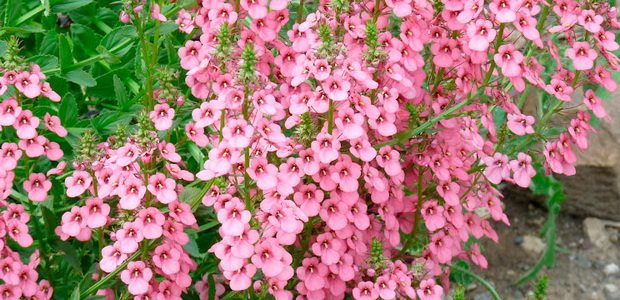

In the upper part of the stems, racemose inflorescences are formed. The flowers are pink, orange, coral, lilac, white, up to 1.5 cm in diameter, similar to shells.
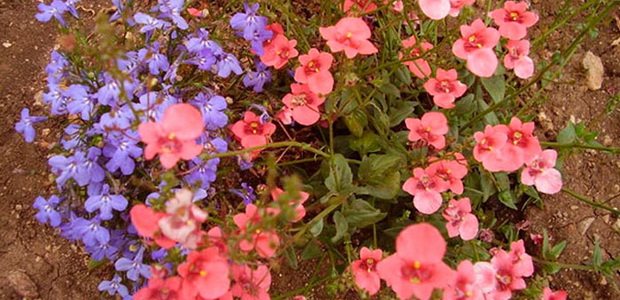

Flowering occurs in early June, lasts until October until frost. During flowering, the bush is densely covered with buds, because of which the leaves are almost invisible. The first wave of flowering occurs in early summer, after which the intensity of bud formation decreases, especially in dry, dry summers. However, closer to autumn and directly on autumn days, the plant again pleases the eye with an abundance of bright colors.
Many species of this plant can withstand low temperatures down to -8 ... -15 degrees, but in mid-latitudes it is always grown as an annual.
The description of the diastia flower is supplemented by the photo below, where you can consider all the distinctive features of this culture:
Using diastography in decorating the territory
Diastia looks great in a variety of flower beds, flower beds, small areas, and also effectively complements garden paths. Stony rock gardens with this flower are often found. You can add showiness to the site with the help of hanging pots, floor vases with this ampelous plant.


Solutions look very original when the bush acts as low borders, and is also used as an accent to form with contrasting cultures. Also, the bush is an active guest in decorating gazebos, terraces, open verandas.
Preparing for winter
In general, diastia is considered an annual plant - it dies with the arrival of the first frost. However, the problem can be easily resolved. On the last warm days, carefully cut the healthiest and most beautiful branches from the largest bushes. Place them in a container of water for several days, and when the first roots appear, transplant them into a suitable container.


Then diastia will delight you with beautiful flowers in winter, and in spring it will be possible to plant several seedlings in open ground, so that flowers will appear on the site several weeks earlier than when using seeds.
Landing in the ground
When the threat of the last night frosts has passed (from the beginning to the end of May - depending on the region and climate in a particular year), you can transplant the diastion into the open ground.
To do this, you need to slightly moisten the prepared bed and make several holes in it at a distance of about 15-20 centimeters. It is not worth planting denser - the plants will interfere with each other and because of this, they will get sick more often.
If you choose flower beds or hanging pots instead of beds, then in one container with a volume of six to eight liters, you can plant up to four seedlings. Of course, in this case, you should choose creeping varieties.
Description of the flower
Perennial plants grow on the African mountain slopes, and annuals grow on the plains. In Russia, diastia is more often grown as an annual, since it is not able to withstand temperature changes.
Diascia belongs to the Norichnikov family. It is represented by ampelous, ground cover plants.
Stems are straight, creeping, hanging. In the natural environment, they reach 100 cm in length, in cultivated plants - 30-65 cm. Glossy leaves are located opposite. They are dark green in color, oblong, ovoid with a jagged edge.


Flowers - tubular perianth with five lobes. The three upper lobes have yellow spots at the base and spurs. The three lower ones form a larger lower lip. The flowers reach 2 cm in diameter and resemble a seashell in shape. They are collected in apical inflorescences.
The color can be red, orange, purple, pink, white. Flowering occurs in waves from spring, ending with the first frost. At the peak of flowering, flowers abundantly cover the entire bush, hiding foliage.
Care, watering, keeping in a pot
Diastia develops quite quickly, and buds begin to form two months after sowing. Young shoots that appear abundantly during growth should be pinched several times throughout the growing season. This promotes the formation of new branches, the plant becomes thicker and bushes more.
After flowering, it is necessary to remove the old buds along with the stem, leaving only a petiole about 5 centimeters in length. This drastic measure is necessary for better branching and more bud production.
Despite the fact that diastia is a perennial plant, in open ground in mid-latitudes it is not able to survive the winter temperature drop and dies, therefore it is grown as an annual.
To prevent the plant from dying, you can transplant a flower from open ground into a pot for the winter. In a cool room, the plant will be able to outlast severe frosts, and with the arrival of spring, it will again send diastia to nature, to open ground.
To do this, the diastia is cut in half and transplanted into a pot, in loose soil. The temperature is maintained at about 5 degrees.
With the onset of spring, the plant is hardened for a while, and then planted in open ground.
Diastia can be grown in pots to decorate balconies and loggias.
For this, good drainage is specially made in the pot, since the plant does not like stagnant water.
When growing diastia in the open field, a mixture of soil with coarse sand is prepared for it. For her, more suitable soils will be not very greasy, neutral soils.
The flower loves water, so it needs regular and abundant watering, especially at high summer temperatures.
If the flower grows at home in a pot, then in winter it needs minimal watering.
It is necessary to feed the plant once a month by adding liquid complex fertilizers for flowering plants to the water for irrigation. In this case, it is better not to use organic matter, since the stems of the plant will begin to stretch out, and flowering may stop altogether. And any fertilizer should not be abused, as this leads to abundant growth of deciduous mass and a decrease in flowering.
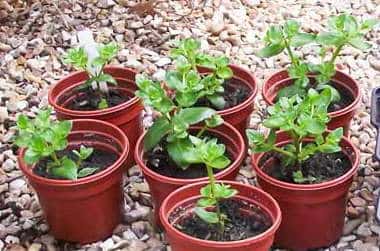

Diastia bearded or Barbera
In total, there are about 50 types of diastia varieties in the world, but only a small part of them are used in gardening.It is worth noting that breeders have bred many varieties of this crop, which are in great demand among gardeners. Their popularity is due to the rich color range of inflorescences and unpretentious care.
Most often, in ornamental gardening, bearded or Barbera diastia (Diascia Barberae) is used - a low-growing strongly branching bush no more than 30 cm high.In temperate latitudes it is grown as an annual plant. It has large, dark green, shiny leaves that form at the base of the stem. The flowers are small, up to 1.5 cm in diameter, pink with a spot inside a more intense color than the petals.
The most famous varieties of bearded diastia:
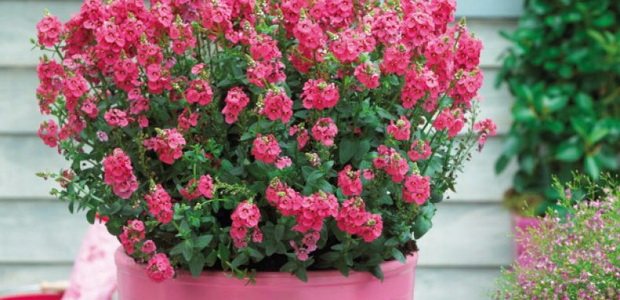

"Basia" - a variety of diastia in demand in horticulture, which is a low bush with drooping velvet inflorescences 2 cm in diameter, bright pink in color. Intense bloom is observed twice a season;
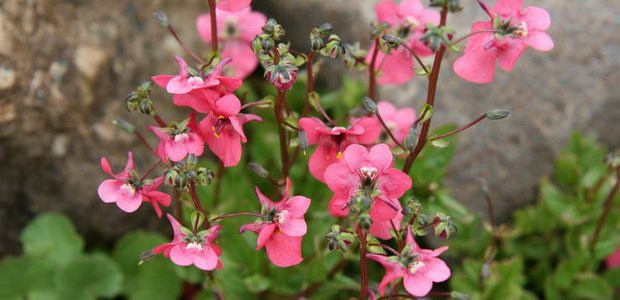

"Ruby Field" - has apical racemose inflorescences of deep pink color;


"Salmon queen" - a spectacular variety with salmon-colored flowers;


"Apricot Queen" - a short bush with light orange buds;
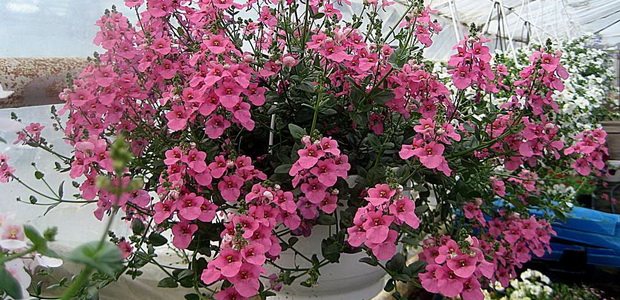

"The Pink Queen" - a variety of diastia with pale pink inflorescences with a diameter of 1.5 cm and lush green foliage. During flowering, the bush looks very bright and elegant.
How is diassage used on the site?
Diastia is a bright, showy plant that is often used to decorate the garden. Thanks to the numerous buds of a rich color, it always brings revival to the flower garden.


The plant is suitable for decorating borders, creating ridges. With its help, colorful flower beds are made, combining several varieties at the same time.
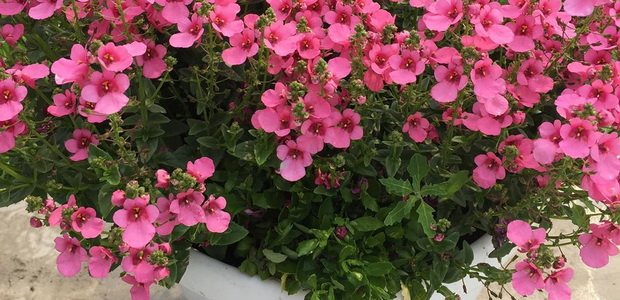

Compact varieties are used to frame more massive ornamental plants in the garden. Creeping varieties are used to create alpine slides. They also use them to decorate empty spaces on the site.
With the help of tall bushes, you can place bright accents on a large green area, add bright colors to it.
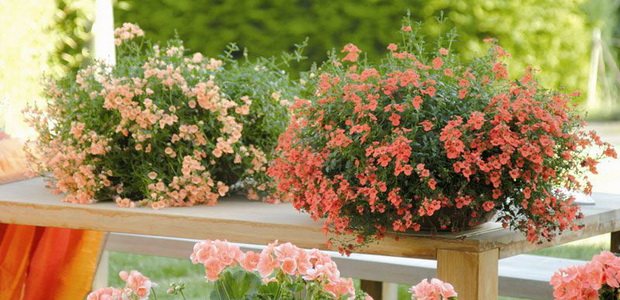

Diastia is also good in garden vases, pots, containers, among other flowering plants. Ampel varieties are perfect for decorating terraces, loggias, verandas, landscaping balconies.
Summer care
After planting, diastia does not require careful maintenance, but it still has to be given a little attention. To maintain its decorative effect, you will need:
- watering as needed;
- occasionally apply fertilizers;
- after the flowering wave, do pruning.
If the diastia is grown in a container or pots, it will have to be watered a little more often than plants in a flower bed. Watering frequency depends on the weather. In the heat, the flowers will need frequent moisture, but in the rainy season, this makes no sense. It is best to water the flowerbed in the morning with preheated water.
As for fertilizers, you need to be extremely careful with their use. From excessive fertilizing, the flower will begin to build up its vegetative mass, and will cease to bloom. It is better not to use organics. After a wave of flowering and subsequent pruning, the flowers must be fed with a complex mineral fertilizer. This is done no more than once a month.
Trimming the diagonal is necessary to maintain decorativeness. They begin to manipulate after the end of the next flowering wave. It is also recommended to remove faded buds in a timely manner, this will allow the plant to bloom for longer. Too long shoots that violate the shape of the bush are cut with pruning shears, for the rest of the stems it is enough to pinch the tips - this will cause tillering.
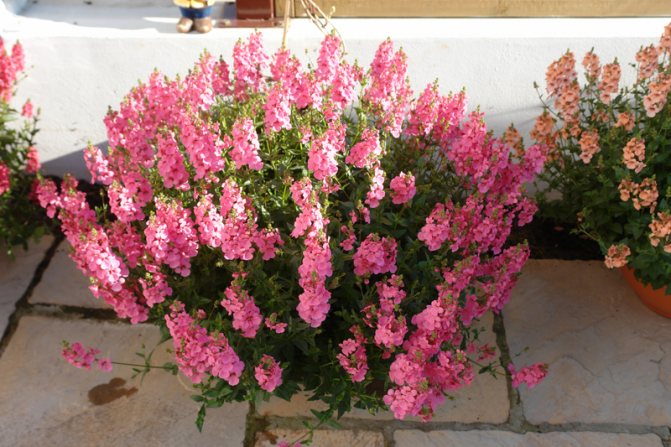

Suitable care
As mentioned above, diastia is not too fond of wet ground. This should be taken into account when growing, if you do not want the root system to start to rot.
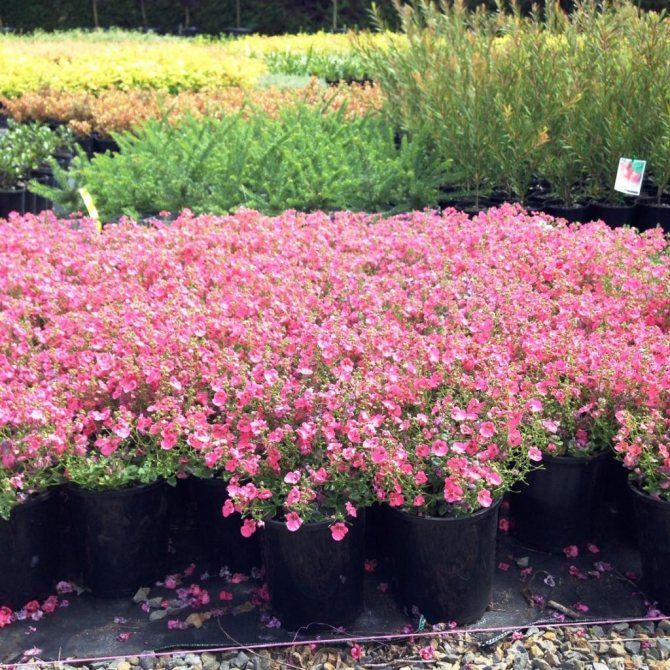

Although this is very strange, but too nutritious soil diastation also does not tolerate. If there is an excess of nutrients, the plant stretches strongly, but practically does not bloom.Therefore, you should not be too zealous with fertilizers. It is enough to water once a month with a weak solution for flowering plants.
After the first flowering (it will end around early to mid-August), you need to prune - remove all branches and the upper part of the stem. Then a second wave of flowering will begin in a few weeks. In order to have more flowers, for one week after pruning, you need to water the plant well, as well as apply nitrogen and potassium fertilizers. They stimulate the development of leaves and stems and increase the number and size of buds.
Germinating seeds
Now let's talk a little about growing diastia from seeds - the photos are presented in the article.
Preparation should begin in mid-February. Then you can be sure that by the beginning - mid-July the plant will delight you with its gorgeous flowers.


In general, everything is quite simple here. It is necessary to put the seeds purchased in the store (collected from the site or taken from friends) in a paper envelope and put it in the refrigerator for a couple of weeks. Thus, you can make them understand that the cold season has passed, and you can germinate.
The next step is soil preparation. It is advisable to take a low, but large in area box, and fill it moderately with a nutritious substrate. A mixture of peat, black soil and fine river sand is suitable.
The seeds are laid out at a distance of 3-4 centimeters from each other and slightly sunk into the moistened soil. After that, you need to cover the box with glass and leave it in a warm, sunny place. The optimum temperature is + 20 ... + 22 degrees Celsius.
After 10-15 days, the first shoots will appear. After another 3-4 days, when most of the seeds of diastia hatch, you need to start airing - remove the glass from the box during the day. On the first day - only fifteen minutes. In the second - for half an hour. In the third - at three quarters of an hour. After about two weeks, you can remove the glass altogether - the plants are already strong enough and can survive without additional protection.
Of course, you shouldn't forget about hydration. It is best to spray the soil and plants with a spray bottle. It's easy, simple, and certainly won't hurt thin stems and leaves. In addition, in this case, it is difficult to moisten the soil too much - diastia does not like excess moisture.


When a second true leaf appears on the sprouts, it is advisable to transplant into small peat or cardboard cups, with which they can be transplanted into open ground.
This concludes the story of growing diastia from seeds. A new stage begins.
Landing rules
Planting a diastia and subsequent care for it will not take you a lot of time and effort - agricultural technology is extremely simple.
It is imperative to plant diastion in a well-lit area, which will be protected from gusts of wind. In this case, the substrate should be loose and light, since this plant does not tolerate stagnant moisture. It is good if the soil is at a neutral pH level.
If you define plants in open ground, then the distance between them should be at least 20 cm. If this is a pots, then in one, the capacity of which will be 6 liters or more, it is allowed to grow up to 4 units of seedlings.
On a note! For diastia, the most preferable is the soil, which contains sand, leaf and sod land in equal proportions!
Video review
Diastia is a bright flowering plant with neat little flowers about 2 cm in diameter. The shape of the diastia flower resembles a seashell. The diastia plant belongs to the Norichnikov family.
The homeland of the plant is Africa, so the diastia survives the hot season perfectly. In their natural environment, annual varieties grow on plains, and perennials are located on mountain slopes.
The plant's rhizome is in the upper layers of the soil. Shoots are smooth or creeping. The leaves of some varieties are serrated, opposite or sessile. Most often they are in the form of an ellipse.The color of the inflorescences is different; orange, white, lilac or pinkish are found. There are approximately 50 varieties.
Wintering plants
In the open field, diastia can winter only in the southern regions. The flower cannot endure the harsh Russian winters, therefore it is possible to grow it in an annual culture or organize wintering indoors.
At room wintering in the fall, the bush is dug out of the flower bed and placed in a pot filled with a loose substrate. The diastia spends the rest period in a bright, ventilated room with an air temperature of 7-10 degrees.
Watering during storage of diastia in winter should be minimal. In the spring, a plant that has wintered under such conditions is cut to a height of 5-6 centimeters and planted in open ground. Despite the previous cultivation of the plant in the open soil, before planting it in the spring, hardening is necessary. To do this, at the onset of the first warm days, the diastia is taken out into the street. At first, the "walk" should last 1-2 hours. Gradually, the time spent in the fresh air is increased.
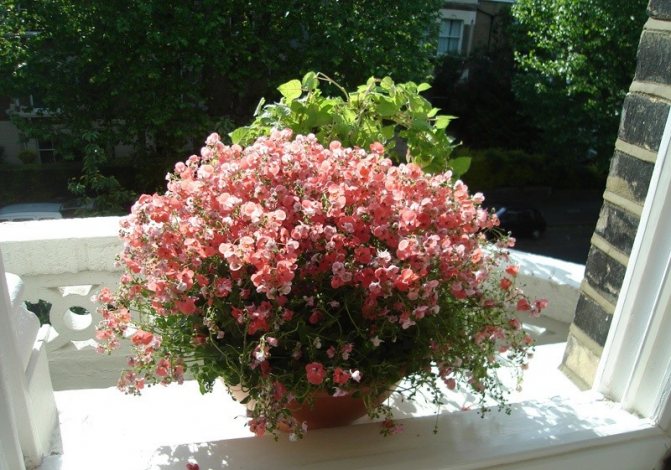

Diastia successfully winters at home in a pot
Some gardeners practice overwintering diascea under dense shelter. However, the spring behavior of the plant testifies to the inexpediency of such wintering. Most often, diastia gets wet after wintering under cover, and its growth and flowering becomes scarce.
Types of diastography
Diascia is a perennial from South Africa, in nature it has a wide variety of species, some of which are used for decoration by flower growers.
In middle latitudes, unfortunately, diastia in the open field can only be grown as an annual plant, since the plant dies at sub-zero temperatures. Therefore, today more and more diastia is grown at home in pots.
Diastia blooms extremely beautifully and profusely, literally turning the bush into a lush bouquet, in which you can not even see the leaves or the pot.
Diascia bearded Diascia barberae
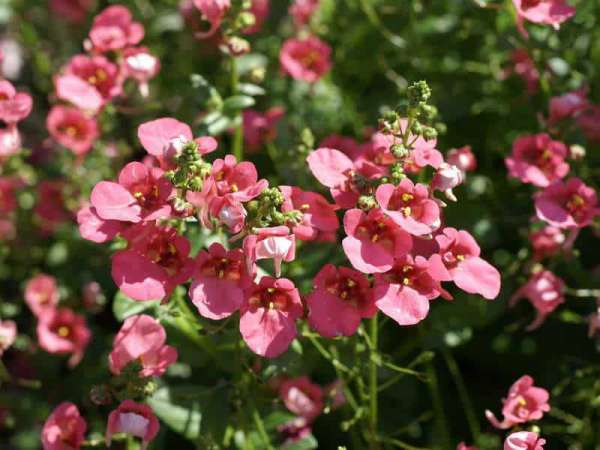

Diastia bearded is a compact bush. Small flowers of various shades adorn the plant throughout the season.
Felt diastia Diascia fetcaniensis
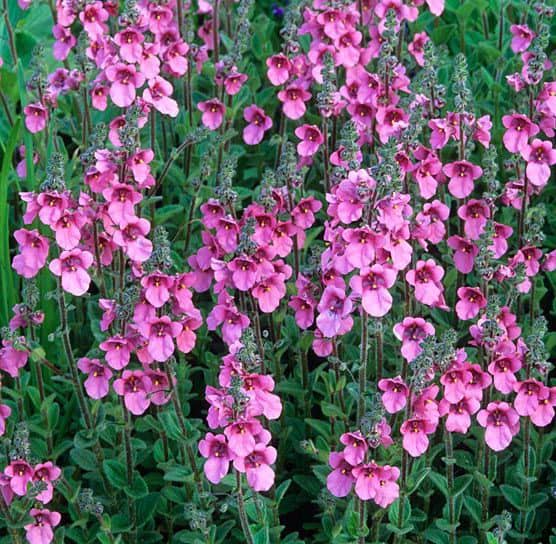

Felt diastia is distinguished by unusually interesting fluffy leaves, and not only amazingly beautiful flowers.
The leaves look like emerald felt napkins, which greatly adorn the flower.
Diascia harsh Diascia rigescens
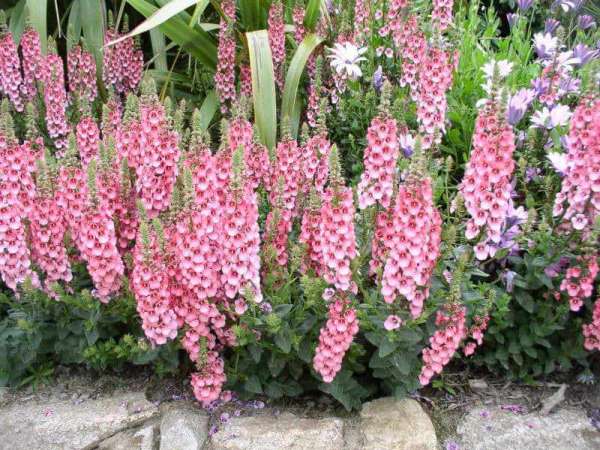

Diastia is harsh, the most cold-resistant of all. Emerald leaves turn reddish-brown in autumn.
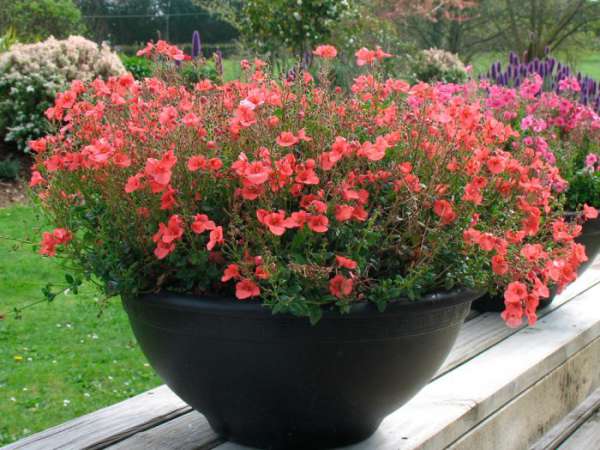

A perennial plant like diastia (Diascia) is grown as an annual on terraces, balconies, in hanging baskets. It is also grown as a ground cover plant. In the wild, diastia can be found in South Africa.
This flower is directly related to the family of vines, as well as bacopa. Its well-known relative is the snapdragon, which has adorned many gardens for many years.
This plant can have a height of 25-30 centimeters. While the diastia is young, its shoots are erect. But a few months after the stems grow, they become drooping, and the flower takes on the appearance of a spreading bush.
Glossy leaves, painted in dark green, are small in size. The flowers are also quite small, but when flowering begins, they are able to completely close the leaves, there are so many of them. The wavelike bloom of diastia lasts a very long time, or rather, from spring to frost. To stimulate flowering, it is necessary to remove the faded stems. Blossoms may be poor during hot and dry summer months. But it should be borne in mind that the plant needs sunlight for abundant flowering.
The flowers are painted in a variety of colors, for example, pink, red, apricot, and also white. Flowering usually begins early enough. So, a seven-centimeter bush already has flowers.
It is not difficult to take care of such a flower, because it can be considered non-capricious.Feels great on an open balcony. It should be watered fairly abundantly, and the soil should not be too nutrient-dense. If you fertilize the diastion excessively, then this can provoke the active growth of the leaves.
Often in the store on sale there is only a type of diascia barberae.


Appearance
Diastia is not particularly bright. Usually this is a plant with short, straight or creeping stems. Although in nature it grows up to one meter, when cultivated in gardens it is much less - usually 25-50 centimeters.
Shoots are covered with small dark green leaves, located opposite one another.
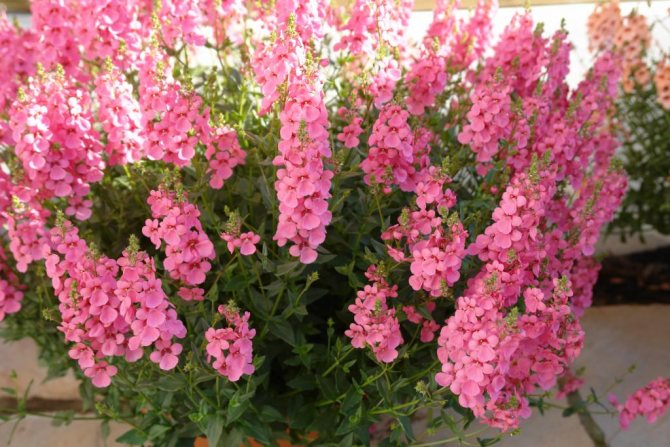

Diastium flowers are rather small, consisting of a tubular perianth and five lobes. Usually their size does not exceed 20 millimeters. But they literally cover the stem, making the plant look very attractive. And the rich color range will not disappoint even the most spoiled connoisseur of colors. If desired, you can easily find varieties that delight the eye with purple, white, red, pink, orange flowers, as well as many others. The main thing here is not to make a mistake and choose just such a variety that would meet the requirements of a particular flower lover. Therefore, it will be very useful to talk about them in a little more detail.

